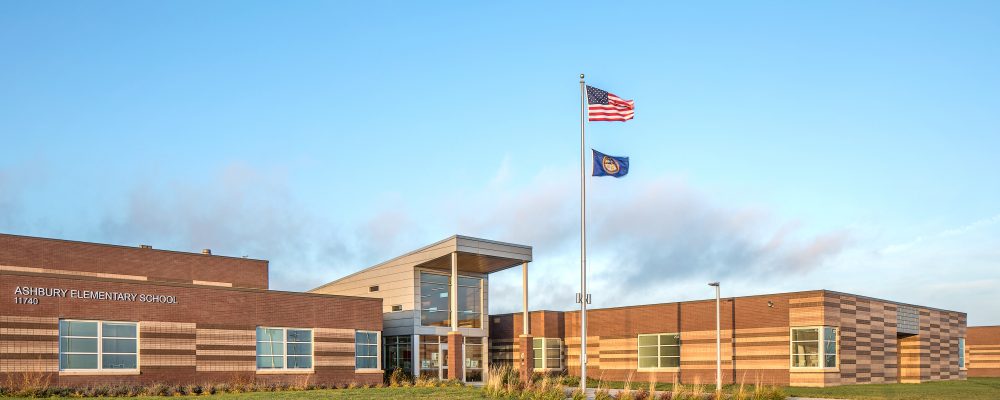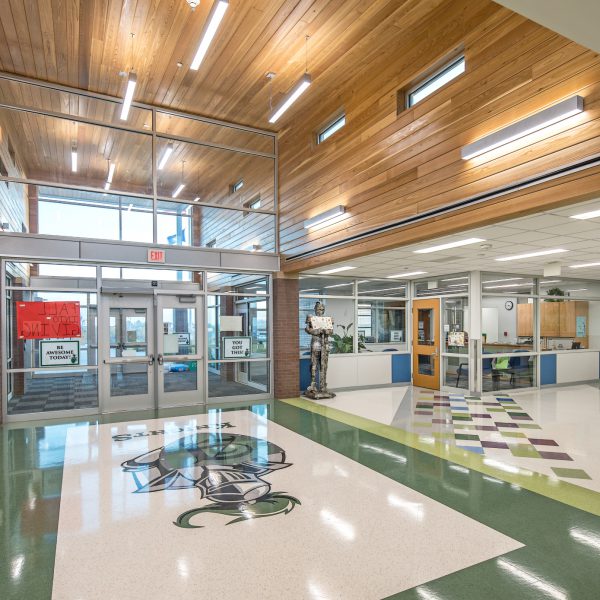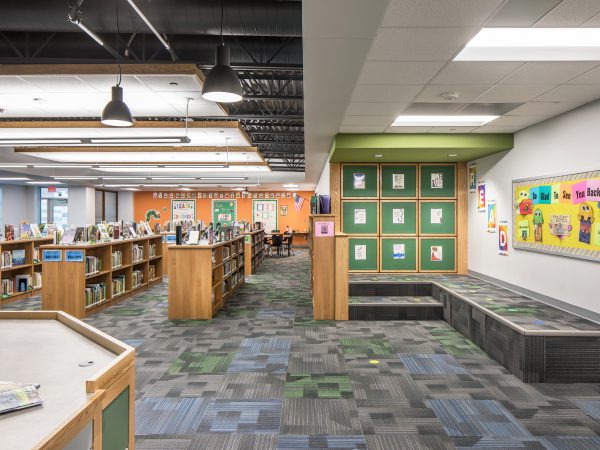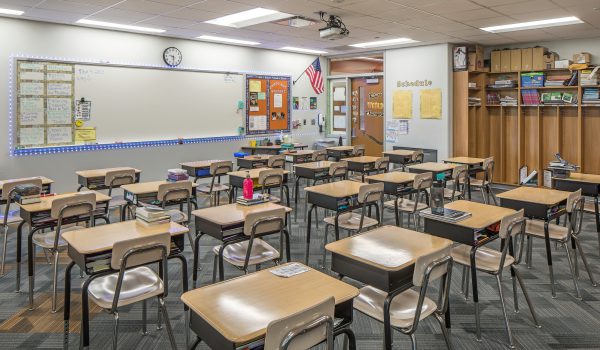Ashbury Elementary Wins ACEC Honor Award

We are honored to share that “Papillion La Vista Community Schools Ashbury Elementary” was awarded the 2023 American Council of Engineering Companies (ACEC) Nebraska Honor Award.
INNOVATIVE DESIGN
Papillion La Vista Community Schools has set out to create a standard for their school district, which Ashbury Elementary followed, but the school also included additional unique features and improvements. For instance, the entire building utilizes LED lighting, improving upon the fluorescent lighting used at Prairie Queen Elementary. This was also the first Papillion La Vista Community Schools facility to use low voltage lighting controls to enable customizations such as programmable dimming. This allowed spaces such as the vestibule, to be programmed to dim the lights to 30% after a set period of inactivity. By doing this, the space meets the code requirements for egress lighting, while also saving energy and money. Other programmable lighting includes the exterior and site lighting, which are controlled by the building management controls system.
The lighting controls system’s occupancy sensors serve a dual purpose in some spaces by also controlling the mechanical systems. When a sensor detects that the room is empty, it triggers the mechanical system to shut off outdoor airflow to the space, saving energy. It also triggers the heat pumps to control the temperature of the room. The insulated concrete forms used in construction also provide a boost to energy efficiency by providing additional thermal insulation and helps with humidity control by resisting moisture. Perhaps the greatest energy asset is the combination of geothermal energy and insulated concrete forms used for the exterior walls. Thanks to this combination, the Ashbury’s mechanical system runs 10% more efficiently than Prairie Queen Elementary, Papillion La Vista Community Schools’ next most recently completed building. Another positive note to the project was the fact that Energy Star gives a median Energy Use Intensity (EUI) of 48.5 for K-12 schools. Ashbury Elementary was approximately 27% below that medium.
The main entrance opens into a high-ceiling Commons space with clerestory windows that allow daylight to flood the space. Mechanical systems, like ductwork, were intentionally routed outside of this space to keep the area clear for better daylight penetration, significantly improving the aesthetic without negatively impacting the budget.

FUTURE VALUE
Geothermal energy is something many school districts like Papillion La Vista Community Schools are looking to implement as a standard. Ashbury Elementary serves as the model that the District hopes to continue to improve upon in future buildings, which is why the lessons learned by the design team as a whole will help make future projects better and more efficient.
In fact, constant improvement is a prominent theme throughout Papillion La Vista Community Schools’ vision. The District has set out to create a standard for their schools with most buildings following a basic design that is customized as needed. However, the District is always looking for ways to improve upon previous designs with every new building. Each one is treated as a new opportunity to continue making Papillion La Vista Community Schools better, more efficient places to learn and grow. This core design team has worked on 10 projects together, which not only increases efficiency throughout the design and construction process, but invites a greater level of innovation.
Building improvements focus on many things, one of which is inspiring students. For instance, one wall of the data center features a window so that students can look in and see the technology equipment in action. The hope is that this will spark students’ interest in learning more about technology and its career opportunities.
BECOMING A CATALYST
Ashbury Elementary addressed a critical need for the expanding Papillion La Vista community. It will serve as the learning hub for new and upcoming neighborhoods, providing students with a wide variety of opportunities in classrooms, the gym, on stage, and more. Not only that, but Ashbury will also provide spaces for after-school activities such as Kids Club and Boy Scouts.
In addition, Ashbury Elementary was the catalyst for the establishment of the infrastructure necessary to develop new neighborhoods in the area. When construction started, the area that would become Ashbury Elementary was nothing more than an empty, undeveloped plot of land. Thanks to the school’s construction, roads and other essentials like water and power lines were routed to the area. While the school was essential in bringing infrastructure to the area, the mechanical team was also conscientious of designing systems that would not create excessive noise for future neighbors. For example, another benefit to the geothermal system is that it eliminated the need for noisy heat rejection units.



COMPLEXITY
The lack of development and infrastructure posed some challenges toward the beginning of the project. The lack of roads made transporting construction materials difficult, while the lack of water, power, and natural gas lines made site visits and electrical/mechanical system progress checks more difficult. Constant rain also delayed pouring concrete and set the schedule back. Despite these challenges, the Alvine Engineering team delivered systems designs on time and kept on top of quality assurance checks.
While having a standard building design can help Papillion La Vista Community Schools maintain consistency and save money across construction projects, it also presents some unique challenges. For example, designing a more energy efficient lighting design within the set building prototype presented some difficulties. One of the solutions was using all LED lighting as opposed to the previously used fluorescents.
Sometimes, the challenge comes in tweaking the improvements. In one case, a teacher had difficulty getting her classroom warmed up in the winter mornings. After some investigation, the mechanical team discovered that every time the teacher left the room during her morning routine, the room sensed that it was unoccupied and stopped supplying warm air. Once, the space was filled with constant movement from students, the system worked perfectly. The team made a quick adjustment to ensure the system would heat to a set point once it detected an occupant and the problem was easily solved. Now, the adjustment is a part of the official design standards, preventing the problem from occurring in future buildings.
DESIGN TEAM
Alvine Engineering was honored to partner with the Owner; Papillion La Vista Community Schools, architect and structural engineer; BCDM Architects, foodservice design; Roger Kruse and Associates, Wallace Engineering, general contractor; Prairie Construction, and civil engineer, Lamp Rynearson, on this project.



